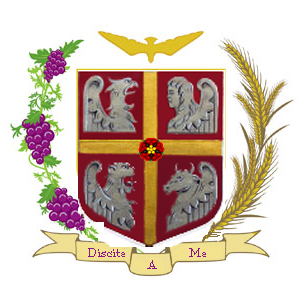Seminary Coat-Of-Arms
On 1st August 2010, the Seminary officially launched its Coat of Arms. With its symbolic elements, the Coat of Arms, serves as an expression of what the Seminary stands for, as well as a reminder to the Community of its identity. Below are the explanations of the various elements that make up the Coat of Arms.

Meaning
|
Shield |
the “armour of God” (Eph 6:11-15) in our walk in The Most Holy’s righteous ways as outlined in the seminary’s core values and to be ever-ready in the service of the Divine.
|
|
Wheat Stalks and Grape Vines |
the Eucharistic spirituality of the seminary which aspires to form men and women who are passionately in love with the Sacramental Mysteries, inclusive of the Eucharist.
|
|
Dove |
the centrality of the Holy Spirit who is the principal formator in seminary formation and who guides, protects and breathes life in the church |
|
Quarter Symbols |
the symbols of the four evangelists which originate from the four “living creatures" that draw the throne-chariot of God, the Merkabah, in the vision in the Book of Ezekiel (Chapter 1) reflected in the Book of Revelation (4.6-9ff)
|
|
Cross |
as Rene Guénon pointed out, the cross is one of the most universal of all symbols and is far from belonging to Christianity alone. While studying scripture, vivid symbols are necessarily pressed into service as reference points-how else could the mind ascend the ladder of analogy to pure intellection? The cross also represents the nature of initiation and Spiritual Realization.
|
|
Rose |
our aspiration to become compassionate leaders after the heart of Christ. Early Christians identified the five petals of the rose with the five wounds of Christ. Since the earliest times, the rose has been an emblem of silence. The rose also symbolizes our communion with the Bishop and the Magisterium.
|
|
Banner with “Learn from me” |
The banner summarizes the motto of the seminary which is derived from Matthew 11:29 “ take up my yoke upon you, and learn from me, because I am meek and humble ... tollite iugum meum super vos et discite a me quia mitis sum et humilis corde ...”
|
Tinctures and Stains
|
Purple (Purpore) |
Represents the steadfastnest and the royalty of priesthood. Purple originally described the dyestuff obtained from sea snails of the species Murex brandaris (commonly called dye murex). The dyestuff, and cloths dyed with it, were known as purpura, in Latin, which in turn was derived from porphura, a Greek word of Phoenician origin which described the shellfish and its dye. The precise colour of the dye is no longer known, but it seems that it may have varied; what it was most prized for was that it was the only colourfast dye known to the ancient world. It is especially associated with the imperial dignity
|
|
Gold (0r) |
Signify generosity.
|
|
Red (Gules) Green (Vert) Tenne (Tawny) Maroon (Murrey) |
represents life and vitality. Hope, loyalty, love Worthwhile Ambition
Maroon is thought to have come from mulberries. Mulberries do not bud until all danger of frost is past, and so they symbolize calculated patience. When they do produce buds, it happens so quickly that it seems to occur overnight, displaying and thus symbolizing expediency and wisdom. For all these attributes, the ancient Greeks dedicated the plant to the goddess of wisdom, Athena. The sun in Chinese legend is represented by the three-legged Sun Bird. This bird resides in the eastern sea, atop a magnificent mulberry tree. This tree is said to be the link between earth and the eastern heaven. |
 Blazon:
Blazon:
Escutcheon classic, murrey, on a cross or surmounted by a rose gules barbed vert and seeded argent proper, quartered: Symbols of the four Evangelists, viz. an Eagle, Angel, Lion, and Bull, displayed argent, crest a dove argent, supporters: dexter, 3 garbs or dexter , grape vine 3 clusters grapes purpore barbed vert, motto: Discite a Me
